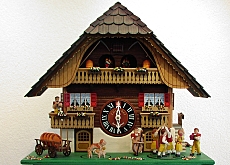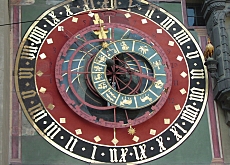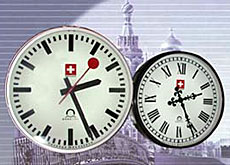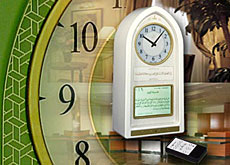Going cuckoo about real Swiss cuckoo clocks

For many tourists the ultimate Swiss souvenir is a cuckoo clock, and the number of shops selling them in all the big cities and resorts won't disappoint.
What could come as a surprise however is learning that Switzerland is not in fact the home of the cuckoo clock and that many of the cheap quartz clocks on sale are made in China, South Korea and Japan.
The Black Forest region of southern Germany is where cuckoo clocks – mostly depicting a hunting scene – have their real nest.
But the Lötscher company, based near Zurich, can boast it makes the only genuine Swiss cuckoo clocks in the world.
“The one we make is the chalet type. It’s typically Swiss and is a Swiss invention,” company director Bijan Vafi told swissinfo.
“It’s made in two parts. One is the wooden part and the other is the mechanical part, made out of metal.”
Top range
The company’s clocks are at the top range of the market, requiring much skill to marry the delicately carved wood and the mechanics.
Lötscher has two facilities in Switzerland, with the woodcarving carried out in the Bernese Oberland village of Brienz – renowned for the skills of its wood workers – and Fällanden near Zurich, where the clocks are assembled.
“It takes about three months to make the wood case. We use linden wood which is naturally dried so it doesn’t crack,” Vafi explained.
Assembling the final clock is no easy matter when you consider that the wood tends to expand and contract.
It might sound un-Swiss that the movement inside Lötscher clocks is German, but there is a very good reason for that.
“We don’t have any factories here making movements for cuckoo clocks. There is only one left and that is in Germany.”
But Lötscher prides itself that all the added value on its clocks is “Swiss made”.
Dancing figurines
Assembly includes adding dancing figurines, waterwheels, animals and of course the cuckoo sound to the chalets.
The mechanical movement is chain driven for one or eight days with cuckoo-call and gong strike every half and full hour. The more popular are those with the one-day movement because, it seems, people like the daily ritual of pulling the chain.
The most popular model is the number 570, which represents a typical chalet of the Bernese Oberland.
“If you go to the resort of Brienz, you can see plenty of them. When people see that particular model, they can see Brienz or the Oberland,” said Vafi. “It’s a memory for them.”
Some of the clocks also feature music boxes, produced for Lötscher by the Reuge company of Sainte-Croix in the canton of Vaud.
Popular tunes
The most popular tunes with the customers have been favourites for years – Edelweiss and Fröhlicher Wanderer (The Happy Wanderer).
“Actually we would be happy to hear something different but they’re still what people like,” Vafi said.
He adds that the cuckoo clock still has a place in today’s world because young and old alike enjoy the contact with it. But there is a hitch.
“It’s not a problem of demand for the cuckoo clock. It’s more a question of whether we will have the skilled workers in the future because young people do not want to do this. They prefer to be with high tech these days.”
A look around the assembly ateliers in Fällanden reveals cuckoo clocks in all shapes and sizes. And the company, which has made three limited editions in the past few years, keeps at least one clock of any model that is discontinued.
“One day I hope we can have a museum in which we can show all the clock models we’ve produced over the years,” Vafi said.
swissinfo, Robert Brookes in Fällanden
Founded in 1920, the Lötscher company is the only genuine Swiss brand of cuckoo clock.
All clocks are hand carved and hand assembled using aged linden wood.
The wood is aged for several years to ensure it won’t warp or crack in humid or dry environments.
This is the most costly way to make cuckoo clocks, but it separates the company from the foreign competition.
Lötcher’s clocks are priced from SFr180 ($144.6) to SFr2,750.
Actor Orson Welles took a swipe at the Swiss in the 1949 film The Third Man after a ride on the Ferris wheel in Vienna’s Prater Park.
In a memorable quote, he said: “In Italy, for 30 years under the Borgias, they had warfare, terror, murder, bloodshed – they produced Michelangelo, Leonardo da Vinci and the Renaissance. In Switzerland, they had brotherly love, 500 years of democracy and peace, and what did they produce? The cuckoo clock.”
Scriptwriter Graham Greene conceded this was not his invention but rather Welles’s contribution to the script.

In compliance with the JTI standards
More: SWI swissinfo.ch certified by the Journalism Trust Initiative











You can find an overview of ongoing debates with our journalists here . Please join us!
If you want to start a conversation about a topic raised in this article or want to report factual errors, email us at english@swissinfo.ch.